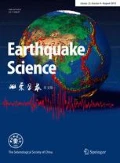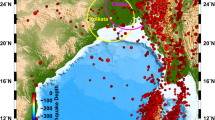Abstract
The principle of middle and long-term earthquake forecast model of spatial and temporal synthesized probability gain and the evaluation of forecast efficiency (R-values) of various forecast methods are introduced in this paper. The R-value method, developed by Xu (1989), is further developed here, and can be applied to more complicated cases. Probability gains in spatial and/or temporal domains and the R-values for different forecast methods are estimated in North China. The synthesized probability gain is then estimated as an example.
Similar content being viewed by others
References
Aki K. 1981. A probabilistic synthesis of precursory phenomena. In: Simpson D W, Richards P G eds. Earthquake Prediction — An International Review. Washington D C: A G U, 566–574
Aki K. 1984. The use of physical model of fault mechanics for earthquake prediction. In: The Organizing Committee of ISCESP ed. A Collection of Papers of International Symposium on Continental Seismicity and Earthquake Prediction. Beijing: Seismological Press, 653–659
Fu Z X. 1991. Studies on temporal heterogeneity of strong seismic event in eastern China mainland. Earthquake Research in China, 7(2): 2–11 (in Chinese)
Jiang M, Wang X Q, Jiang X E. 1993. Time-level structure of seismic activity in eastern mainland of China. Earthquake, 13(1): 16–20 (in Chinese)
Jin X S, Dai Y H, Ma G H. 1997. A probability gain model applied to long-term earthquake forecast (Abstract). In: Department of Scientific Development, China Seismological Bureau ed. Researches on Forecast Risk of Strong Earthquake in Chinese Mainland Occurring before 2000. Beijing: Seismological Press, 321 (in Chinese)
Kagan Y, Knopoff L. 1977. Earthquake risk prediction as a stochastic process. Phys Earth Planet Inter, 14: 97–108
Kenji M, Akio Y. 1990. A probabilistic estimation of earthquake occurrence on the basis of the appearance times of multiple precursory phenomena. J Phys Earth, 38: 431–444
Li Q Z, Yu X C. 1980. The characteristics of grouping activity of great earthquakes in North China. Scientific Research on Earthquake, (1): 1–8 (in Chinese)
Ma Z J, Fu Z X, Zhang Y Z, et al. 1983. The Nine Great Earthquakes in China during 1966–1976. Beijing: Seismological Press, 216 (in Chinese)
Mei S R. 1960. The seismicity in China. Acta Geophysica Sinica, 9(1): 1–19 (in Chinese)
Mei S R, Feng D Y, Zhang G M, et al. 1993. Introduction to Earthquake Prediction in China. Beijing: Seismological Press, 498 (in Chinese)
Shi Z L, Huang W L, Cao X L, et al. 1974. Some characteristics of seismicity in China. Acta Geophysica Sinica, 17(1): 1–13 (in Chinese)
Utsu T. 1977. Probabilities in earthquake prediction. Zisin Ser, 30(2): 179–185 (in Japanese)
Utsu T. 1979. Calculation of the probability of success of an earthquake prediction (in the case of Lzu-Oshima-Kinkai earthquake of 1978). Rep Coord Cpomm Earthq Predict, 21: 164–166 (in Japanese)
Utsu T. 1983. Probabilities associated with earthquake prediction and their relationships. Earthq Predict Res, 2: 105–144
Utsu T. 1984. Long and short-term seismic risk estimation from seismicity and precursors. In: The Organizing Committee of ISCESP ed. A Collection of Papers of International Symposium on Continental Seismicity and Earthquake Prediction. Beijing: Seismological Press, 818–827
Vere-Jones D. 1978. Earthquake prediction—a statistician view. J Phys Earth, 26: 129–146
Xu S X. 1973. An example of analyzing earthquake precursors. In: Editorial office of Earthquake Battle Front ed. Collection of Earthquake and Technical Data. Beijing: Science Press, 20–23 (in Chinese)
Xu S X. 1989. The assessment of efficiency of earthquake prediction. In: Department of Science, Technique and Monitoring, China Seismological Bureau ed. Corpus of Practical Methods of Earthquake Prediction: A Special Collection of Seismology. Beijing: Seismological Press, 586–590 (in Chinese)
Zhang G M, Fu Z X. 1985. The time sequences of strong earthquakes in North China and their explanation. Acta Geophysica Sinica, 28(6): 569–578 (in Chinese)
Zhang L R. 1998. Assessment of probability gains of prediction methods in medium and long-term Prediction. Earthquake, 18(4): 331–336 (in Chinese)
Zhang Y Z, Zhang L R, Su S P, et al. 1992. Gradient of vertical rates and high-risk areas of strong earthquake in China. Seismology and Geology, 14(3): 237–244 (in Chinese)
Author information
Authors and Affiliations
Additional information
The paper is sponsored by the Key Project (95-04-07-04-01) during Ninth “Five-Year” Plan from China Seismological Bureau.
About this article
Cite this article
Wang, XQ., Fu, ZX., Zhang, LR. et al. Spatial and temporal synthesized probability gain for middle and long-term earthquake forecast and its preliminary application. Acta Seimol. Sin. 13, 50–60 (2000). https://doi.org/10.1007/s11589-000-0081-0
Received:
Revised:
Accepted:
Issue Date:
DOI: https://doi.org/10.1007/s11589-000-0081-0




